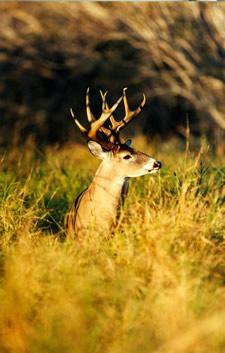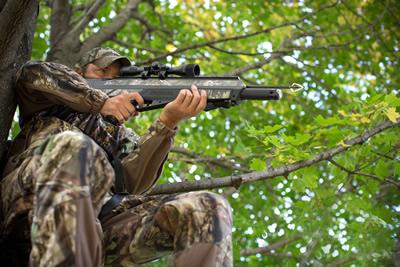 November 17, 2017 - Texas whitetail deer hunters love their cat and mouse game, and they may soon have more time to play it - two weeks to be exact - in the 226 counties that comprise the state's North deer hunting zone.
November 17, 2017 - Texas whitetail deer hunters love their cat and mouse game, and they may soon have more time to play it - two weeks to be exact - in the 226 counties that comprise the state's North deer hunting zone.
That's the word from Alan Cain, white-tailed deer program leader with the Texas Parks and Wildlife Department.
According to Cain, TPWD is considering adding two weeks to the end of general deer season in the North Zone so as to bring the deer season structure in most of Texas in line with that of the South Zone and ultimately create more hunting opportunity statewide.
The South Zone encompasses 30 "brush country" counties including a five-county cluster widely known as the "Golden Triangle" because of its reputation for producing some of the biggest bucks in the land.
The current season structure calls for a general season opening date that falls on the first Saturday in November in both the North and South zones. However, the season closing dates in the two zones are significantly different. South Zone hunters are allowed to hunt through the third Sunday in January while the North Zone season ends on the first Sunday in January.
Cain says the department has fielded numerous requests over the last several years to create some uniformity between season closing dates in the two zones by adding two weeks to the North Zone season.
Last May, a TPWD constituent filed a formal petition for rulemaking with the department asking for uniform start and end dates of general white-tailed deer season statewide, Cain said.
The petition put the wheels of discussion in motion among wildlife leaders in Austin, which ultimately lead to a presentation of the facts and possible implications of such change to the TPW Commission earlier this month during its work session/regional hearing held in Lufkin.
At this point, Cain says he and other wildlife staff see no biological reason to deny extending the general season two weeks in the North Zone, a move that would be sure to bolster hunter opportunity with no negative impact to the resource.
"Why not add a couple of weeks of extra hunter opportunity if there is no biological reason not to do it?" Cain said. "We don’t expect harvest to increase much with an additional two weeks in the North Zone."
Cain backed the theory with years of big game harvest survey data.
"The data indicates that only about 13 percent of the total statewide harvest occurs after January 1, even though the special late season, muzzleloader season, late youth season, South Zone general season and managed lands deer properties are all open after January 1," he said.
In other words, there aren't very many white-tailed deer killed in Texas after New Year's Day, possibly because most hunters are burned out, their hunting kitties are tapped, or a combination of both.
"When you look at harvest chronology peak harvest statewide occurs the opening weekend, and around the holidays of Thanksgiving as well as the week around Christmas, probably when kids are out of school and folks are taking time off for the holidays," Cain said. "After January 1 hunting drops considerably. We wouldn’t expect an additional two weeks to impact the deer population, especially when some of our deer monitoring units have high deer densities that need to be reduced."
While there are no negative biological impacts standing the way of extending the season, Cain said there could be some possible sociological implications to consider.
"Although staff doesn’t see any biological concerns we do hear comment from hunters/landowners that may not be supportive of such a change," he said. "Some folks say deer season is already too long and would prefer not to have hunters out on their properties for an additional two weeks. Some are concerned hunters will harvest shed-antlered bucks later in January and others say extending the season will interfere with quail hunting, predator calling contests and squirrel hunting with dogs in East Texas, all of which generally occur later in the winter."
There is a rock-solid counter to those arguments:
Just because a season framework allows for hunting doesn't mean landowners and lease managers have to go along with it. Cain says property owners and individual hunting clubs are well within their rights to make rules specific for their land or club, so long as they fall within the boundaries of what is allowed by TPWD regs.
"Since Texas is a private lands state landowners are ultimately the ones in charge of access on their properties," Cain said. "They have the flexibility to limit hunting on their property whether that is day hunters, package hunts, or season lease hunters."
As earlier mentioned, bringing uniformity to the opening and closing dates of general deer season in the North and South zones is just a discussion at this time. However, it will more than likely become a formal proposal as early as January and go through TPWD public hearing process next spring. If passed, the new rule could go into effect as early as the 2018-19 season.
Cain and other wildlife leaders are interested to learn how the hunting public might feel about such a change. Whether you like the idea of extending the season or leaving things as they are, TPWD wants to know about it.
"We could find out there are an overwhelming number of people who don't want it or we could find out that there is a lot of support or than nobody really cares," Cain said. "We'll just have to wait and we what comes out of it."
Mule deer, air bows and big-bore rifles
 TPWD also is taking a wait-and-see approach to a series of other possible hunting reg changes that could be put in place as early as next fall, including placing an experimental 20-inch outside spread antler restriction on mule deer bucks in Cottle, Hall, Briscoe, Childress, Floyd and Motley counties in the Panhandle.
TPWD also is taking a wait-and-see approach to a series of other possible hunting reg changes that could be put in place as early as next fall, including placing an experimental 20-inch outside spread antler restriction on mule deer bucks in Cottle, Hall, Briscoe, Childress, Floyd and Motley counties in the Panhandle.
Biologists say the antler restriction is under consideration in the Panhandle counties because they believe it could help curtail the excessive harvest of young bucks that occurs there and help improve the age structure within the herd.
Antler restrictions have a rich history in Texas and have played a key role in improving the age structure of whitetail bucks in dozens of East Texas counties where a 13-inch minimum regulation has been in place for several years. Antler restrictions on white-tailed deer are currently in effect in more than 100 counties.
It's only logical to assume that protecting young mule deer bucks from harvest would leaded to more older bucks on the landscape. Biologists think it would be a good idea to put the restriction place for at least four seasons to give them a good read on the impacts.
Two other potential reg changes under consideration include the legalization of air bows and big bore air rifles that meet minimum requirements for hunting deer and other game animals. Both came about as the result of public petitions.
What's an "air bow?"
It operates similar to a crossbow in that you aim it like a gun and use a trigger to fling an arrow at super-fast speeds. Difference is air bows rely on compressed air to propel arrows and are much easier to arm and disarm than a crossbow, compound or recurve bow.
Crosman is manufacturing an air bow called the Benjamin Pioneer that reportedly can be cocked with two fingers and will fire eight shots in the same amount of time it takes to shoot a crossbow three times. Arrows are propelled at 450 feet per second using an integrated pressure regulator pumped to 3000 psi.
The bow is reportedly very accurate and capable of taking down big game animals with a well-placed shot. There is a video on the company website that shows television host Jim Shockey using the air bow to bring down a bison with a single shot.
Just so you know before ordering one, the air bow doesn't come cheap. Crosman advertises it for around $1,000, including a scope, sling, quiver and nine arrows.
Big bore air rifles also rely on compressed air to fire large caliber pellets at super-fast speeds with an effective range similar to today's muzzleloaders. They are available in a range of calibers with big bore models like the .45, .357 and .457 delivering gobs of knock down power.
Not surprisingly, the modern big bores command prices much taller than the Daisy air guns many of us grew up with. You can buy one for around $750, but some cost upwards of $2,000.
It's going to be interesting to see how all of this stuff shakes out. More hunter opportunity is never a bad thing. If air bows and big bore air rifles bring new recruits to the sport then bring 'em on.
I'll stick with my .270 and compound bow, though.
Matt Williams is a freelance writer based in Nacogdoches. He can be reached by e-mail, mattwillwrite4u@yahoo.com.









